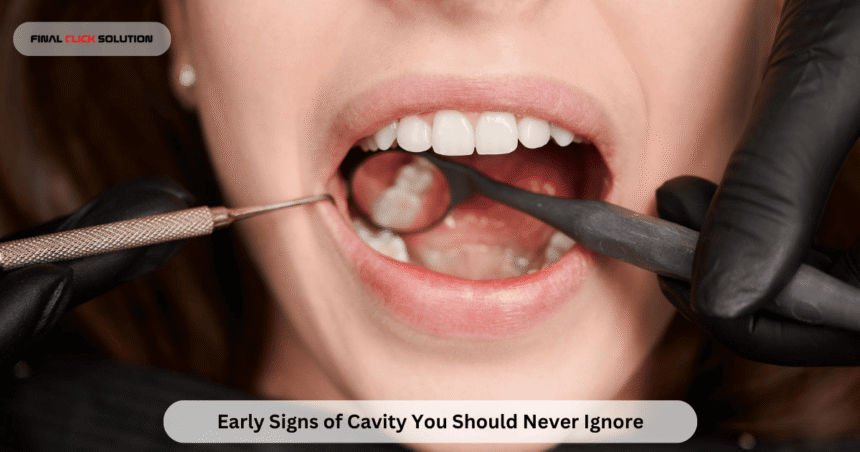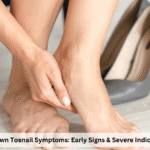Tooth cavities—also known as dental caries—are among the most common oral health issues worldwide. They affect children, adults, and seniors alike, often starting silently and becoming painful only when the damage has progressed. Recognizing the early signs of cavity can help you seek treatment before complications arise. Cavities don’t appear suddenly. They form over time as acids from bacteria and food combine to break down enamel, the outermost layer of the tooth. If left untreated, the decay can spread to deeper layers, causing infection, abscesses, and even tooth loss.
This comprehensive guide breaks down every stage of cavity development, early warning signs, symptoms of advanced decay, and how to differentiate cavity pain from other dental issues. Understanding these signs empowers you to take action early, protect your oral health, and prevent future dental problems.
Understanding How Cavities Form
Before diving into the signs, it’s helpful to understand the process behind cavity formation. Cavities develop when the enamel is repeatedly exposed to acids produced by plaque—a sticky bacterial film on teeth. Every time you consume sugary or starchy foods, the bacteria break them down into acids. These acids erode the enamel, eventually creating small holes. Over time, the decay penetrates deeper into the dentin and pulp, triggering pain and more serious complications.
While cavities are common, they are highly preventable with proper oral hygiene and routine dental visits. Still, many people miss the early clues, allowing decay to advance.
Early Signs of Cavity
Cavities give subtle warnings in the beginning. These early symptoms are not usually painful, but they signal that decay has started. Detecting them early can prevent costly treatments like root canals or extractions.
Tooth Sensitivity
One of the first signs of a cavity is tooth sensitivity. You might feel a sudden sharp or tingling sensation when eating or drinking something hot, cold, sweet, or acidic. This occurs because enamel erosion exposes the underlying dentin, which contains tiny tubes that lead to the tooth’s nerve. Sensitivity at this early stage may come and go, making it easy to ignore. However, consistent sensitivity is an early indicator that decay has begun.
Visible White Spots
White spots on your teeth are another early sign of demineralization—the first stage of decay. These chalky patches indicate enamel breakdown and signal that the tooth is losing minerals. At this point, the cavity can often be reversed through fluoride treatments, dietary changes, and improved oral hygiene.
Mild Tooth Discomfort
A small, dull ache or occasional discomfort when chewing may also indicate the beginning of a cavity. While this pain might seem insignificant, it often reflects early dentin exposure. People frequently dismiss this mild discomfort, but it can quickly worsen if untreated.
Bad Breath That Won’t Go Away
Persistent bad breath or a bad taste in your mouth may result from bacteria buildup associated with cavities. Even with regular brushing and mouthwash, the odor may persist because the decayed area harbors bacteria deep within the tooth.
Rough or Chalky Feeling on the Tooth Surface
Running your tongue along your teeth may reveal an area that feels rougher or stickier. This texture change can indicate enamel erosion and early cavity development.
Visible Signs of Developing Cavities
As the cavity progresses, the symptoms become more noticeable and harder to ignore. At this stage, dental treatment is necessary to prevent further damage.
Brown, Black, or Dark Spots
Once decay advances, the white spots may turn dark. Cavities often appear as brown, black, or grayish discolorations on the tooth surface. These spots can be tiny or spread across larger areas, depending on the severity of decay. Discoloration is a strong sign that the enamel has been compromised and bacteria have penetrated deeper layers.
Holes or Pits in the Teeth
When enamel erosion continues, it creates small holes or pits. Sometimes you can feel these holes with your tongue. At this point, the cavity has progressed past the reversible stage and must be restored with a filling. Ignoring these holes will lead to deeper decay and potential nerve damage.
Increased Sensitivity to Sweet Foods
Sensitivity specifically triggered by sugary foods or drinks often indicates dentin exposure. Sweets penetrate the weakened enamel easily and irritate the nerve endings inside the tooth.
Pain When Eating
Cavities may cause pain while chewing or biting, especially when eating hard or sticky foods. This discomfort means that decay has spread significantly within the tooth.
Advanced Signs of Cavity
When cavities are left untreated, symptoms intensify. The decay reaches the inner pulp of the tooth, where nerves and blood vessels reside, resulting in severe pain and infection.
Persistent Toothache
By far the most recognizable sign of an advanced cavity is a constant toothache. This pain may be throbbing, sharp, or radiating. It often worsens at night or when lying down because increased blood flow puts pressure on the infected area.
Swelling or Redness in the Gums
If decay spreads to the gums or the root of the tooth, you may notice swelling, redness, or tenderness around the affected tooth. This could indicate infection or an abscess forming beneath the gumline.
Pus or Abscess Formation
An abscess is a serious warning sign requiring immediate dental attention. You may notice pus, gum swelling, or a pimple-like bump on the gums. This indicates that bacteria have entered the tooth pulp and created an infection. Left untreated, this infection can spread to the jaw, neck, or bloodstream.
Severe Sensitivity to Temperature
When cavities reach the pulp, even mild temperatures—such as room-temperature water—can trigger intense pain. This heightened sensitivity is a sign that nerve damage is occurring or already advanced.
Loose Tooth
In later stages, the tooth may become loose from bone loss or infection around the root. This is a dental emergency and often results in the need for extraction if treatment is delayed.
Cavity Pain vs. Other Types of Dental Pain
Not all tooth pain is caused by cavities. Gum disease, cracked teeth, sinus infections, and enamel erosion can cause similar symptoms. However, cavity pain typically follows patterns such as:
- Increased sensitivity to sweetness
- Sharp pain when biting down
- Visible holes or discoloration
- Pain that worsens over time
If you’re unsure, a dental exam is the best way to identify the cause.
When to See a Dentist
You should see a dentist as soon as you notice:
- Persistent sensitivity lasting more than a few days
- Toothache of any intensity
- Visible spots, holes, or discoloration
- Bad breath that doesn’t go away
- Pain when chewing
- Gum swelling or redness
Cavities treated early often only require a simple filling. Delayed treatment may lead to root canals, crowns, or extractions.
How Dentists Diagnose Cavities
Dentists use several tools to detect cavities:
- Visual examination
- Dental probing to check for soft spots
- X-rays to detect hidden decay
- Laser caries detection devices
- Intraoral cameras to spot early enamel defects
Early detection means less invasive treatment and greater chances of saving the tooth.
Treatment Options for Cavities
The type of treatment depends on how advanced the cavity is.
Fluoride Treatment
During early enamel demineralization, fluoride helps rebuild and strengthen weakened areas. Fluoride varnishes or gels can reverse early decay before a cavity forms.
Dental Fillings
Once decay breaks through the enamel, the dentist removes the damaged area and restores the tooth with a filling (composite or amalgam).
Dental Crowns
For large cavities that weaken the tooth structure, a crown may be needed to protect the tooth and restore its function.
Root Canal Treatment
If decay reaches the pulp, a root canal removes the infected tissue, cleans the inside of the tooth, and seals it.
Tooth Extraction
In severe cases where the tooth cannot be saved, extraction is necessary. This is followed by replacement options such as implants, bridges, or dentures.
Preventing Cavities Before They Start
Prevention is always better than cure. Here’s how you can reduce your risk:
Practice Good Oral Hygiene
Brush twice daily with fluoride toothpaste and floss at least once a day.
Reduce Sugar Intake
Frequent consumption of sugary beverages and snacks fuels cavity-causing bacteria.
Drink Plenty of Water
Water helps wash away food particles and neutralizes acids.
Use Fluoride
Fluoride strengthens enamel and prevents early decay.
Eat a Balanced Diet
Foods high in calcium, phosphorus, and fiber help maintain strong teeth.
Visit the Dentist Regularly
Routine checkups and cleanings help detect early signs of cavities and prevent progression.
Final Thoughts
Cavities are common, but they don’t have to be inevitable. Understanding the signs of cavity—from early sensitivity and white spots to advanced toothache and gum swelling—can help you seek timely treatment. Early detection not only saves your teeth but also saves you time, discomfort, and costly dental procedures. Maintaining good oral hygiene, eating the right foods, limiting sugar, and visiting the dentist regularly are the best ways to ensure your teeth stay healthy for years to come.
If you notice any symptoms, even mild ones, don’t ignore them. Cavities grow silently but can cause major problems if left untreated. Taking action early is the key to protecting your oral health.






